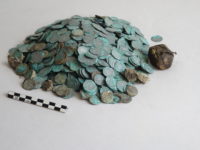 A hoard of hidden medieval treasure, a fortune in gold and silver coins, was an unexpectedly discovered during an excavation at the site of the famed medieval Abbey of Cluny in Saône-et-Loire, eastern France. The team, which includes nine students doing field work as part of the University Lumière Lyon 2’s archaeology masters program, unearthed the hoard in mid-September while looking for the remains of an infirmary believed to have been located there in the Middle Ages.
A hoard of hidden medieval treasure, a fortune in gold and silver coins, was an unexpectedly discovered during an excavation at the site of the famed medieval Abbey of Cluny in Saône-et-Loire, eastern France. The team, which includes nine students doing field work as part of the University Lumière Lyon 2’s archaeology masters program, unearthed the hoard in mid-September while looking for the remains of an infirmary believed to have been located there in the Middle Ages.
The medieval loot included 2,200 deniers (or pieces of silver) mostly issued by Cluny Abbey itself as well as 21 gold dinar coins, originally from the Middle East which were stored in a canvas bag.
The bounty also included a gold signet ring marked with the word “Avete” — a “word of greeting in a religious context” — as well as a folded 24-gram gold leaf and gold coin.
“The overall value of this treasure for the time is estimated between three and eight horses, the equivalent of cars nowadays, but in terms of the running of the abbey it’s not that much, amounting to about six days of supply of bread and wine,” said specialist Vincent Borrel.
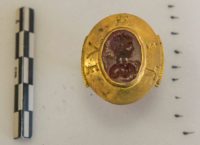 In terms of archaeological and historical value, this treasure is off the charts. It is the first 12th century Cluniac treasure discovered in its original context during an archaeological excavation. It’s also the largest number of silver deniers discovered in one place and the only single hoard ever found to include Arabic coins, silver deniers and a signet ring. The intaglio stone is ancient Roman and engraved with the profile of a deity. (Religious context or no religious context, ancient engravings were prestige items and often used as signet rings by the medieval elite.)
In terms of archaeological and historical value, this treasure is off the charts. It is the first 12th century Cluniac treasure discovered in its original context during an archaeological excavation. It’s also the largest number of silver deniers discovered in one place and the only single hoard ever found to include Arabic coins, silver deniers and a signet ring. The intaglio stone is ancient Roman and engraved with the profile of a deity. (Religious context or no religious context, ancient engravings were prestige items and often used as signet rings by the medieval elite.)
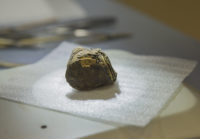 Also of note is the survival of fragments of the original bag the hoard was stashed in. Fragments of it are still attached to some of the coins. There is also a surviving piece of tanned animal hide which was tied around the bundle of 21 gold dinars minted between 1121 and 1131 in Spain and Morocco during the reign of Almoravid sultan Ali Ben Youssef (1106-1143).
Also of note is the survival of fragments of the original bag the hoard was stashed in. Fragments of it are still attached to some of the coins. There is also a surviving piece of tanned animal hide which was tied around the bundle of 21 gold dinars minted between 1121 and 1131 in Spain and Morocco during the reign of Almoravid sultan Ali Ben Youssef (1106-1143).
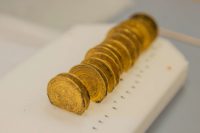 Practically from the time of its founding by by Duke William I of Aquitaine in 910 A.D., the Benedictine monastery of Cluny was one of the great monastic centers of Western Europe. They followed a strict interpretation of the Rule of Saint Benedict that within decades had catapulted Cluny to the top of the ranks, making the abbey the undoubted leader in European monasticism. The city of Cluny grew into a city thanks largely to the Abbey and the trade, employment and pilgrim moneys it brought to town. By the second half of the 10th century, the Abbey of Cluny was already well-established as the top monastery in the country and it retained its prominence into the 12th century.
Practically from the time of its founding by by Duke William I of Aquitaine in 910 A.D., the Benedictine monastery of Cluny was one of the great monastic centers of Western Europe. They followed a strict interpretation of the Rule of Saint Benedict that within decades had catapulted Cluny to the top of the ranks, making the abbey the undoubted leader in European monasticism. The city of Cluny grew into a city thanks largely to the Abbey and the trade, employment and pilgrim moneys it brought to town. By the second half of the 10th century, the Abbey of Cluny was already well-established as the top monastery in the country and it retained its prominence into the 12th century.
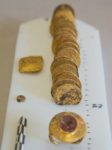 Its influence began to wane when newer, more austere orders stole Benedictine thunder and the idea of remote rule by a single abbot, distant from the satellite houses and largely unaccountable, lost its appeal. In the 16th century the Abbey of Cluny was sacked by Hugenots and never really recovered. Come the French Revolution, the monastic order was dissolved and under Napoleon the abbey itself was demolished and used as a quarry. Today only one of its eight grand towers still stands, which is why archaeologists continue to excavate it today, 90 years after the first archaeological explorations of the site began.
Its influence began to wane when newer, more austere orders stole Benedictine thunder and the idea of remote rule by a single abbot, distant from the satellite houses and largely unaccountable, lost its appeal. In the 16th century the Abbey of Cluny was sacked by Hugenots and never really recovered. Come the French Revolution, the monastic order was dissolved and under Napoleon the abbey itself was demolished and used as a quarry. Today only one of its eight grand towers still stands, which is why archaeologists continue to excavate it today, 90 years after the first archaeological explorations of the site began.
Nice piece of leather packaging, I wonder why they were hoarded?
The gold signet ring, with its intaglio stone, was not just historically important. It was also aesthetically very pleasing and compared well with gold work from a more modern era.
1. Yes, I suspect any order could be more austere if the Cluniacs were eating and drinking the value of a car every six days.
2. Was it normal practice to spell out a word counterclockwise on a medieval ring?
3. Woe betide the graduate student who actually found the horde–that name is somehow omitted from the news article–but the thesis director’s name is there front and center. Graduate student existence always was feudal.
The stone in the ring depicts a bearded male wearing a laurel and holding what looks like a club resting over his shoulder, reduced to baton size to fit the oval. Hercules?
Words that are mirrored and do run counterclockwise on a signet ring are probably not really a surprise.
‘Avete’ is -as far as I could tell- simply the ‘Vocative’ in plural of ‘Ave’. Thus, it is always a group that is greeted with this signet.
The inlay looks a bit ‘clumsy’, and almost as if someone had tried to combine the images of an ancient Roman Emperor and that of a ‘Hercules’ (cf. the club).
:hattip:
———-
PS: I think I own rather current coins from somewhere in the Middle East -unfortunately thicker and no gold- but they don’t look totally different, or in other words those gold coins look almost modern, and well designed, i.e. not ‘clumsy’ at all.
Those obscure coins of mine might simply be modern ‘dinars’ :confused:
What kind of hide were the gold coins found in ? Did the (animal) owner of the hide live in Africa or -as wild boar (or whatever)- in Europe ?
The tiny round piece of gold might be the leftover from some manufacturing process involving gold. The last of the molten gold from the crucible and not quite enough for another coin or whatever.
The fact that the deniers have discolored to a green color may indicate that the monks of Cluny were debasing their “silver” coins rather generously. High silver content coins tend to tarnish and discolor to black. The green indicates to me a high copper content.
Yes, “pure” silver would turn black with Oxygen. However, a Copper content of roughly 5 – 7 percent in ancient silver coins is pretty much normal –and– it makes the alloy harder. Yes, there is indeed Copper, but there is a legit purpose :yes:
Dear Vickie,
Silver coinage was debased numerous times throughout history. Some Byzantine coins got down to single digit percentages of silver. Royal French coinage was debased dozens of times throughout the middle ages, usually by about 5% but sometimes much more. So, the idea that the Cluny coinage had enough base metal in the alloy to cause green discoloration is consistent with other “silver” coins of the period.
It was usually pretty hard to keep the debasement secret. First, there were enough people involved in the minting process that the news that the silver content was being cut would leak out. Second, once the silver content gets low enough the color changes while in circulation. Certain German coins were known as “white pfennigs” because their silver content was high enough to keep a light color during circulation.
All this resulted in value being determined by weight and origin of the coins than by face value. So, a coin of X origin, even though it was the same size and nominal value, might only be considered to be worth half the value of a coin of Y origin because it was known that X was using less silver in its coin alloy.
Also, debasement was the basis of inflation because everyone knew that it would take more coins to buy the same amount of anything because there was less precious metal in the debased coins.
After the discovery of silver ore in the Harz Mountains and other places in Europe the silver content of coins tended to be higher.
The shape of the “A” at the top of the ring is most interesting. Reminiscent of the “A” Durer used in his signature.